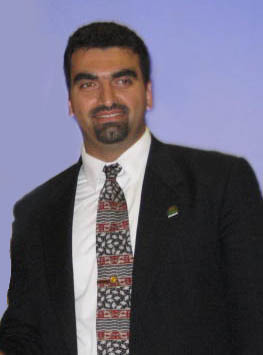Dr. Redwan M. Alqasemi
The Discovery article Wheelchair arm controlled by thought alone said
“A wheelchair-mounted robotic arm controlled by thought alone has been created by scientists at the University of South Florida.The device could give people with amytrophic lateral sclerosis (ALS) or full body paralysis the ability to perform simple day to day functions that would otherwise be impossible.
‘We aren’t reading people’s thoughts,’ said Redwan Alqasemi, a scientist at the University of South Florida who, along with Rajiv Dubey and Emanuel Donchin of USF, helped develop the software and hardware. ‘This is the first time a person with severe disabilities like ALS can perform daily activities for themselves.’”
Redwan M. Alqasemi, Ph.D. is Adjunct Professor at the University of South Florida and a lead researcher in the Center for Rehabilitation Engineering and Technology.
He has published more than 35 technical papers in national and international journals and conferences. His research interests include mobile and redundant robots, rehabilitation and assistive device technologies, artificial intelligence, autonomous and telerobotic applications, virtual reality simulation, haptic and brain-computer interfaces, smart electro-mechanical systems and mechatronics, mechanical systems and controls, and mechanical vibrations.
Redwan is a member of the American Society for Mechanical Engineers (ASME), The Institution of Electrical and Electronics Engineers (IEEE), Robotics and Automation Society, and the Tau-Beta-Pi and Phi-Kappa-Phi honor societies.
Redwan has been the recipient of many awards, including the best project award by Boeing and Raytheon aircraft companies for designing and building a wall-climbing robot for aircraft maintenance. He served in many regional, national and international journals conferences as a reviewer, session chair, and organizing committee chair.
He is currently leading research teams for the following supported projects: smart Wheelchair-Mounted Robotic Arm System (WMRA), Brain-Computer Interface with WMRA, Telerobotics and Haptic Interfaces, and Adaptive Driving Simulation for People with Disabilities.
Redwan coauthored Analysis, Evaluation and Development of Wheelchair-Mounted Robotic Arms, Selection Considerations and a Comparison of Commercial Wheelchair Mounted Robotic Arms, Control of a 9-DoF Wheelchair-Mounted Robotic Arm System, A Double Claw Robotic End-Effector Design, Wheelchair-mounted Robotic Arms: Kinematic Analysis and Evaluation, Telemanipulation Assistance Based on Motion Intention Recognition, and Weighted singularity-robust inverse with criterion function optimization of redundant mobile manipulators in 3D space with defense applications.
He earned his B.S. in Mechanical Engineering at King Abdulaziz University, Kingdom of Saudi Arabia in 1995, his M.S. in Mechanical Engineering at Wichita State University, USA in 2001, and his Ph.D. in Mechanical Engineering at the University of South Florida in 2007 with the dissertation Maximizing manipulation capabilities of persons with disabilities using a smart 9-degree-of-freedom wheelchair-mounted robotic arm system.
Read his LinkedIn profile.
